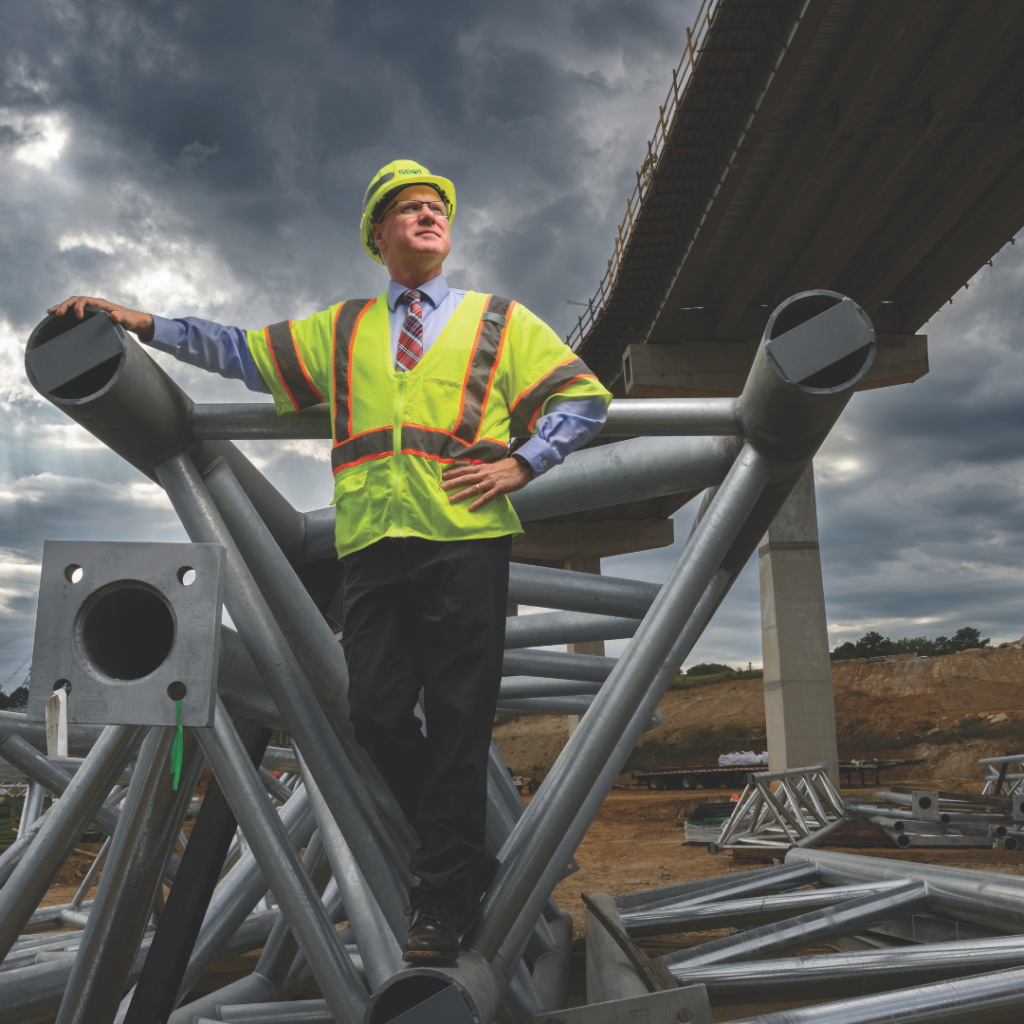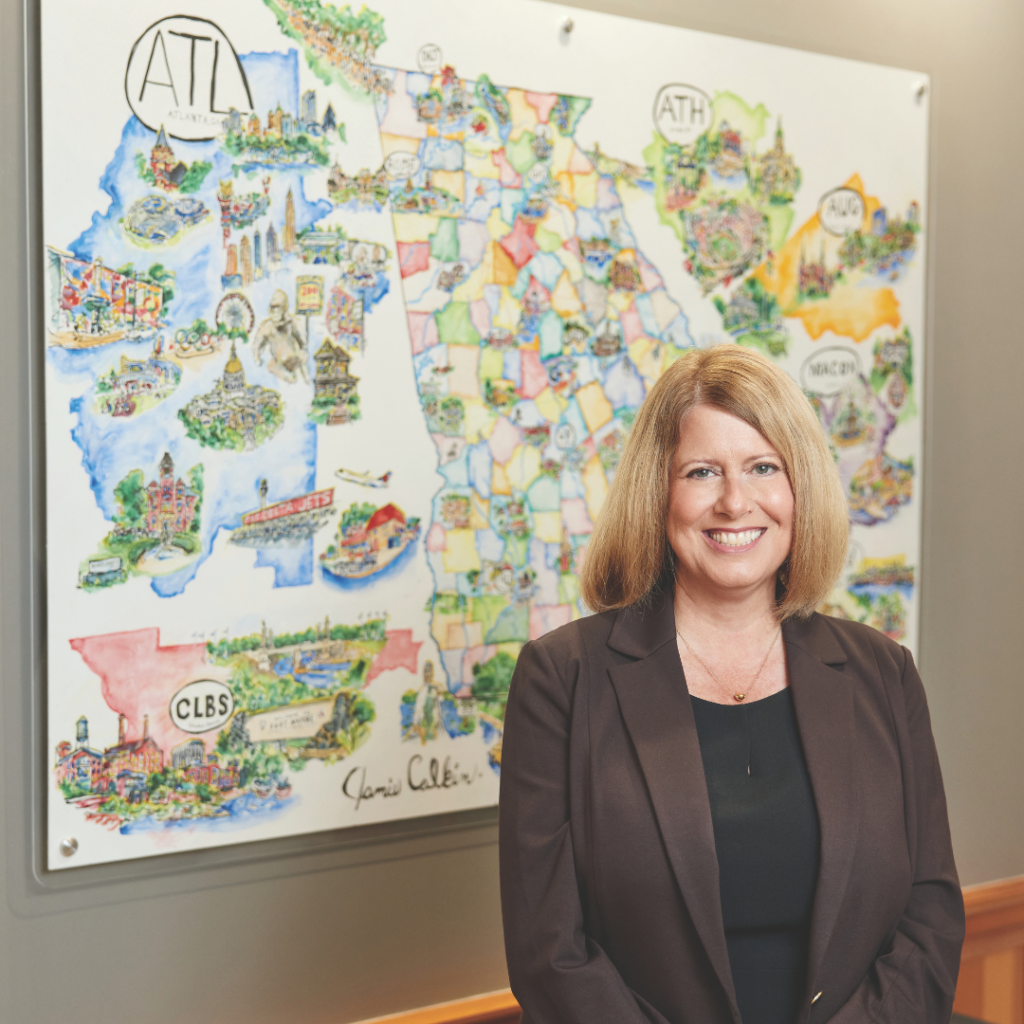Breast Cancer Breakthroughs
People at high risk for breast cancer are benefiting from a heightened focus on prevention and personalized treatment of the disease.

Surgeon and Survivor: Dr. Alicia Arnold, breast program director at the Georgia Cancer Center at Wellstar MCG Health. | Photo Hillary Rumsey
Alicia Arnold was just finishing her third year of medical school when she found a lump in her breast. It was a discovery that would change her life.
“To be honest, I really thought it was nothing,” she says. “I assumed it was a cyst or something. I was so young, and there was no family history of any cancer.” She had a workup done and received good news: The lump appeared benign.
But – fortunately, as it turns out – the mass was painful, which prompted her to have it removed. Three days later, she got the report that she had invasive breast cancer. It was, she says, a massive shock – all the more so because breast cancer usually isn’t painful. That’s why Arnold says she was lucky that it hurt.
She took a leave of absence from med school to have another surgery, which included removing lymph nodes under her arm after tests showed the cancer had spread to one node, followed by chemotherapy and radiation.
Afterward, Arnold returned to school, only to find herself paired with a breast surgeon during her clinical surgery rotation. She remembers thinking, “Oh my God, the last thing I want anything to do with is breast cancer.” It turned out to be just the opposite.
“I connected with these patients,” says Dr. Arnold, now a breast surgeon herself and director of the breast program at the Georgia Cancer Center at the Medical College of Georgia (MCG) in Augusta, which is now affiliated with Wellstar. She recalls seeing one patient during her student clinical rotations who was very anxious and upset about what a chemo port would look like. “I just pulled down my collar and said, ‘It’s going to look like this.’”
Arnold, who was recently named program director of the general surgery residency program at MCG, came to understand that she would always be “very driven about this disease. I’m never going to burn out.” She doesn’t always share her story with her patients. “It’s their journey,” she says. “I make it all about them.” But if someone asks, or seems to be struggling – especially if they are a younger patient – Arnold says she might tell them about her experiences to help calm their fears. She remembers that “it was really nice to see a survivor during [my treatment process] because it helped you see somebody on the other side of it and see they’re living a normal life. [And you think,] ‘I’m going to get there, too.’”
In the 15 years since Arnold’s diagnosis, advances in detection and treatment mean that more women who are diagnosed with breast cancer are becoming long-term survivors. From 2014-2020, the overall five-year relative survival rate for women diagnosed with breast cancer was 91.2%. And from 2013-2022, death rates overall have been falling on average 1.2% each year.
Still, about 13% of women will be diagnosed with breast cancer during their lifetimes. And it matters how early the cancer is found: The five-year relative survival rate for stage 1 female breast cancer, where the tumor has not spread outside the breast, is 99.6%. It is 86.7% if cancer has spread to the lymph nodes.
It’s not all good news. There’s been a worrisome increase in death rates among younger women since 2010, which researchers think is because more young women are being diagnosed with metastatic breast cancer, meaning the cancer has spread through the body. Young women are less likely to get mammograms to screen for cancer than older women, so the cancer may go undetected until it has spread. And racial disparities still exist: For a decade, Black women have had a lower incidence of breast cancer, but a higher death rate from the disease.
As a perfect example of where the field was before [about 2004-2006], HER2+ breast cancer was one of the most aggressive subtypes we treated. But now with treatments that target HER2 … it’s one of the most treatable breast cancers.” Kevin Kalinsky, director of the Glenn Family Breast Center
Researchers and doctors are trying to address these issues to improve survival rates for everyone. In addition to new treatments, along with developments that improve quality of life for people during and after treatment, one of the biggest changes has been recognizing that, as Arnold says, breast cancer is a very individualized disease.
Personalized Prevention
The prevention, diagnosis and treatment of breast cancer has changed thanks to personalized medicine (also called precision or individualized medicine), which considers a patient’s genetic makeup as well as the genes or other markers that are found on the cancer cells in their body.
One example (technically, two examples) are mutations in the BRCA genes, BRCA-1 and BRCA-2, which are inherited from your parents. Women who inherit harmful mutations of BRCA-1 or BRCA-2 have a significantly increased risk of getting breast cancer and ovarian cancer.
Depending on family history, women who are diagnosed with breast cancer may be tested for the harmful mutations. Some breast cancer centers, like the one at GCC, test all women who are diagnosed. But these genes are not the only factors that raise a woman’s risk, and many places, including GCC, Emory University’s Winship Cancer Institute, Piedmont Hospital and the Northside Hospital Cancer Institute, have developed programs or clinics to identify and care for women at high risk.
Surprisingly, not everyone who is at higher risk actually knows it. William Barber,medical director, Helen S. Carlos High-Risk Breast Clinic
Piedmont launched a clinic specifically for women and breast cancer prevention and early detection, the Helen S. Carlos High-Risk Breast Clinic, in 2023. Dr. William Barber, a breast surgeon who is medical director of the clinic, says the goal is to identify people at higher risk and educate them on how to reduce their risk. “Surprisingly, not everyone who is at higher risk actually knows it,” he says. The clinic asks women who come in for their annual screening mammograms to answer an electronic questionnaire that gauges their risk. Beyond genetics, other factors that influence risk include how old a woman was when she started or stopped having periods, history of pregnancy and breastfeeding, obesity and lifestyle factors like alcohol consumption. If the data shows their risk is elevated, a nurse navigator calls them and suggests they be seen at the high-risk clinic.

Providing Expertise: Dr. Walter Curran, chief of Piedmont Oncology Institute (left), and Dr. William Barber, medical director of the Helen S. Carlos High-Risk Breast Clinic (right). | Photo credit: Kevin Garrett
That allows women at high risk to meet with a nurse practitioner who specializes in breast cancer care and is also a genetic counselor, Barber says. If a woman’s lifetime risk is over 20%, she may be advised to have breast MRI screening in addition to mammography. “It gets really important when we look at genetic testing and find that some of these patients have a mutation that increases their risk of getting breast cancer,” Barber says. He notes that as much as the treatment of breast cancer has changed with personalized medicine, Piedmont’s clinic is trying to do the same with prevention. “This starts with identifying people at increased risk, educating them and giving them better options,” he says.
“We’re starting to see a trend toward more high-risk assessments,” says Emily Beard, R.N., program coordinator of breast cancer and GYN oncology at Northside Hospital Cancer Institute (NHCI), adding that Northside is incorporating a risk assessment questionnaire at all of its imaging locations this year and will refer women at high risk to its clinic for people who have an elevated risk of developing cancer.
Even for women who aren’t at an increased risk, newer screening technologies like 3D mammograms have become the standard. And the ongoing, nationwide WISDOM study (Women Informed to Screen Depending on Measures of Risk) is investigating whether a personalized approach to screening leads to better outcomes.
More Tailored Treatments
While medicine is just starting to incorporate personalized prevention programs, it is a little further along in using information about the genetic differences among breast cancer cells to develop targeted therapies.

Major Advances: Dr. Kevin Kalinsky, director of the Glenn Family Breast Center at Emory’s Winship Cancer Institute. | Photo credit: Kevin Garrett
Knowing the subtype of breast cancer cells helps doctors guide treatment and, in some cases, avoid overtreatment. Some cancer cells are sensitive to the hormones estrogen and progesterone. They are said to be hormone-receptor positive, or ER+ (for estrogen receptor positive) and PR+. Some cancer cells can make too much of a protein called HER2 that makes them grow quickly. Cancer cells can have a combination of these factors, and there are hormone therapies and treatments targeted to the HER2 protein. Breast cancer in which the cells don’t have any of these factors is called triple-negative breast cancer and is harder to treat, although there are new therapies available and in the pipeline.
“As a perfect example of where the field was before [about 2004-2006], HER2+ breast cancer was one of the most aggressive subtypes we treated,” says Dr. Kevin Kalinsky, director of the Glenn Family Breast Center at Emory’s Winship Cancer Institute. “But now with treatments that target HER2 … it’s one of the most treatable breast cancers. We really moved to further understanding the biology, so that our treatments are more specific and tailored. That’s true even for our patients with metastatic breast cancer.”
“There are exceptions, but with most types of breast cancer, different subtypes will respond well to treatment, and people can live even with metastatic breast cancer now for years,” says Beard.

Assessing Risks: Emily Beard, R.N., program coordinator of breast cancer and GYN oncology at Northside Hospital Cancer Institute. | Photo credit: contributed
There have been recent breakthroughs in treating triple-negative breast cancer, which tends to be aggressive and has a lower survival rate. It is also diagnosed almost three times more often in Black women. “The biggest advances in triple-negative breast cancer have been immunotherapy and drugs called antibody-drug conjugates or ADCs,” says Kalinsky. The drug Keytruda, which is a kind of drug called an immune checkpoint inhibitor and helps the body’s own immune system attack and kill cancer cells, represented a major advance in treating triple-negative breast cancer when it was approved in 2021. “The whole class of immunity checkpoint inhibitors have been demonstrated to show … a benefit to many women with triple-negative breast cancer,” says Dr. Walter Curran, chief of Piedmont Oncology Institute.
ADCs, another promising therapy, also deliver chemo directly to the cancer cells, sparing other healthy cells. Kalinsky describes them as “like GPS drugs” that target a specific protein on the cancer cells and then navigate straight to their target with the chemo. Two ADCs are approved to treat HER2+ breast cancer, and one is approved to treat hormone-receptor-positive and triple-negative metastatic breast cancer. Kalinsky says researchers are looking to see whether these drugs would help women with high-risk, early-stage breast cancer avoid a recurrence of cancer. More ADCs are in clinical trials, and Curran says that trials are underway to test a vaccine. “The hope is that mRNA vaccines, not unlike the COVID vaccines, could activate a patient’s immune system against triple-negative breast cancer,” he says.
“There are exceptions, but with most types of breast cancer, different subtypes will respond well to treatment, and people can live even with metastatic breast cancer now for years.” Emily Beard, R.N., program coordinator of breast cancer and GYN oncology at Northside Hospital Cancer Institute
Avoiding Overtreatment
The personalized approach to treatment also includes discoveries about who doesn’t need some kinds of treatment. “When I was a medical student, all patients got chemotherapy,” says Kalinsky. “Now we have tumor-based tests that let us know if you [would] benefit from chemo or not.” Kalinsky was the lead author on a “practice-changing” study in 2020 that found that some post-menopausal women with early-stage breast cancer could safely avoid having chemo.
Doctors and researchers have also realized how important quality-of-life improvements are for patients. For example, when lymph nodes under the arm are removed during surgery or treated with radiation, it can cause a buildup of fluid and swelling of that arm called lymphedema. It can be painful, and some people are self-conscious about how it looks. At GCC, a lymphedema prevention program uses precise measurements to identify lymphedema early. “It can pick up when women are starting to develop lymphedema before it’s obvious on exam,” says Arnold. Catching it early can help it stop progressing, although it can’t be cured. Arnold says she also performs a lymphedema preventive technique during surgery and currently has a study investigating data on whether and how much these efforts reduce lymphedema.

Raising Awareness: The pink ribbon has become the universal symbol of breast cancer. | Photo credit: Shutterstock
In the past, “lymphedema was something people didn’t really focus on,” Arnold says. “It was like, ‘Oh, that’s just one of those things you might deal with.’ Well, it’s a pretty big deal. When you have unequal arm swelling, it affects people’s daily quality of life, their job, their pain, and more.”
There have also been advances in reconstructive surgery that Barber describes as “dramatic and extensive.” Many patients opt for immediate reconstruction at the same time as a mastectomy, and a newer procedure called DIEP flap takes skin and soft tissue from the patient’s abdomen to form a new breast, while sparing abdominal muscles. “You don’t lose support for your back. You don’t have to worry about abdominal hernias,” says Barber about the complications that sometimes came from an older abdominal flap. “It creates a reconstruction that is soft and more closely resembles the natural breast than an implant does.”
New issues like preserving fertility, which can be affected temporarily and sometimes permanently by chemo and other treatments, may also transform the landscape. Fertility preservation is especially relevant as more young women are being diagnosed with breast cancer. Arnold, who had her eggs frozen thanks to “all my friends getting together and having a fundraiser [to pay for it],” is working to promote legislation requiring insurance coverage for fertility-preserving procedures for women undergoing cancer treatment. “There was a federal mandate in the ’90s that insurance must cover reconstruction for all women undergoing mastectomy, which is wonderful,” she says. “It should be a federally mandated law that all reproductive services are free or covered for cancer patients. That would be phenomenal.”







